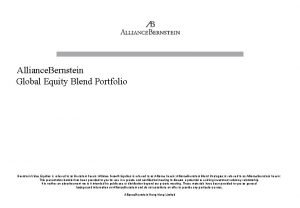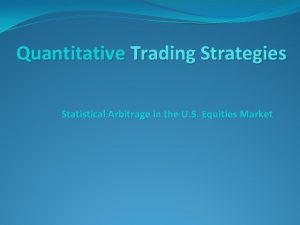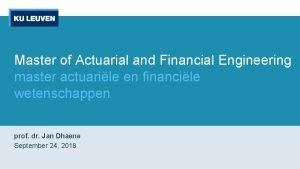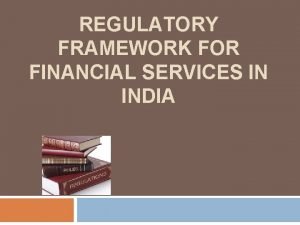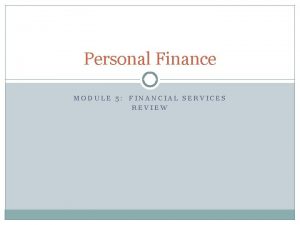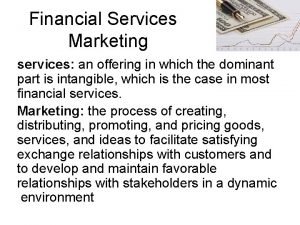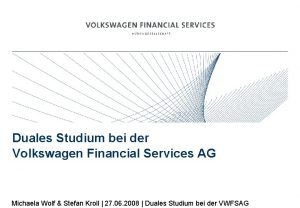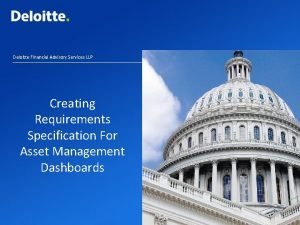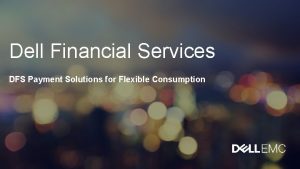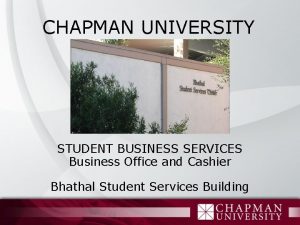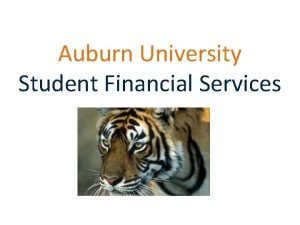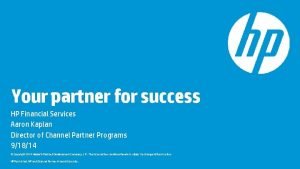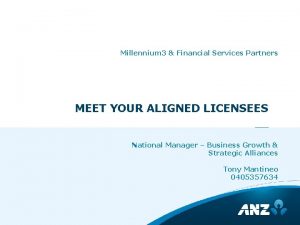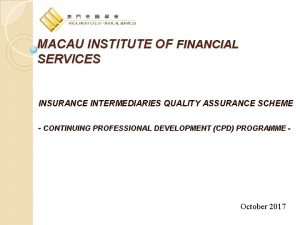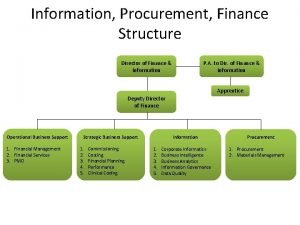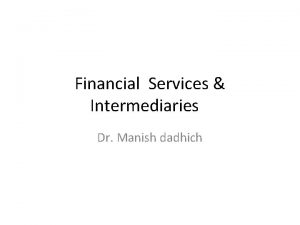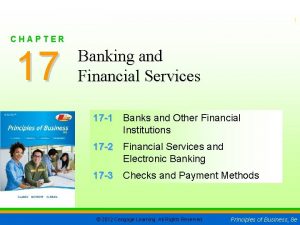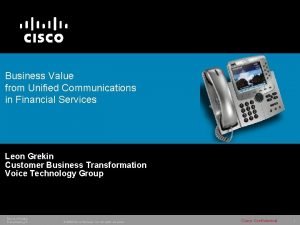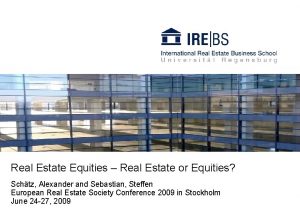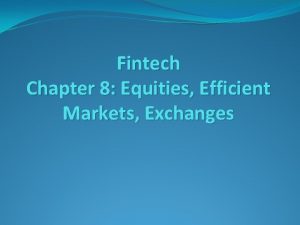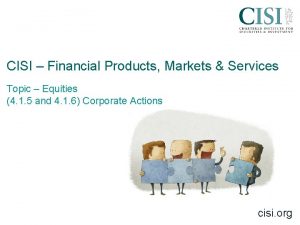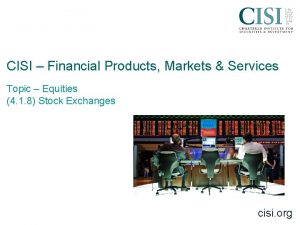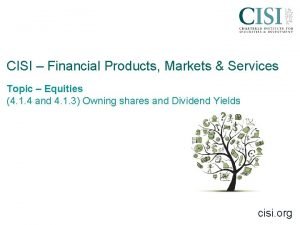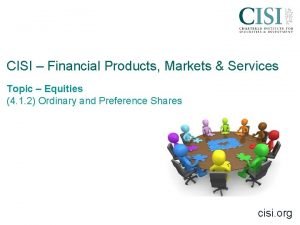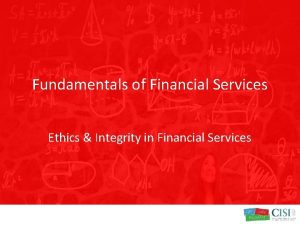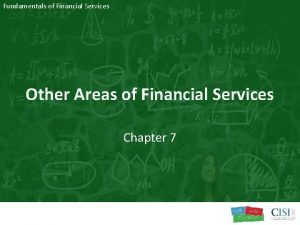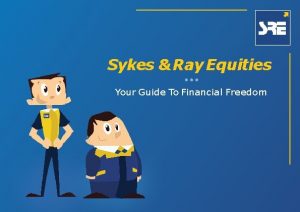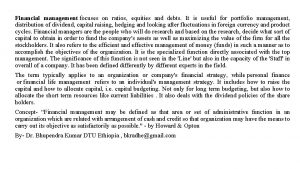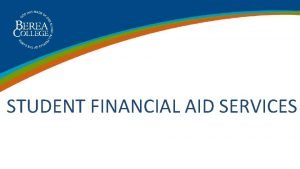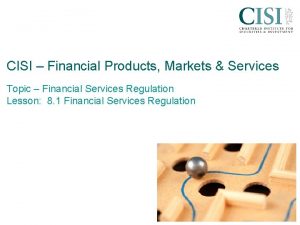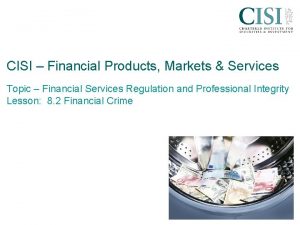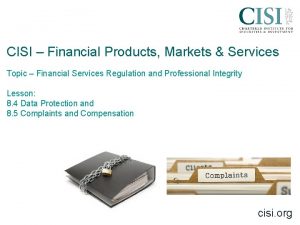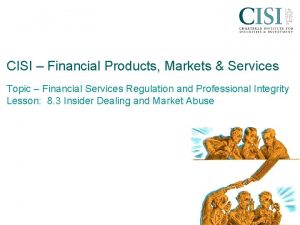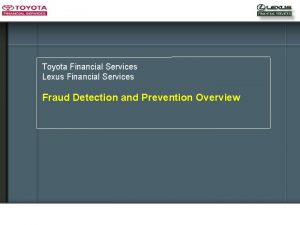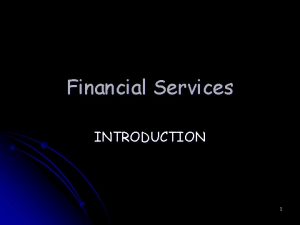Fundamentals of Financial Services Equities Equities Topics to






























- Slides: 30

Fundamentals of Financial Services Equities

Equities: Topics to Cover • • • The Reasons for Issuing Shares Initial Public Offerings (IPOs) Potential Returns from Shares Shareholder Voting Rights The Risks Involved in Owning Shares

Learning Objectives By the end of the session: Everyone MUST: • Know the reasons for issuing shares • Know the definition of an IPO • Know the potential sources of return from shares: dividend; capital gain Most SHOULD: • Be able to calculate the dividend yield given the share price and the dividends paid in the year • Know that shares provide their owners with the right to vote at company meetings/assemblies • Know the risks involved in owning shares: lack of profit; bankruptcy/collapse

Dragon’s Den Video Activity Watch the pitch given to the Dragons. Group 1 – note down positive elements of the business which would encourage you to invest in it. Group 2 – note down negative elements of the business which would deter you from investing in it.

Why issue shares? Why do you think a new business would issue shares (sell equity)? Why do you think an established business would want to issue shares (sell equity)? Mind-Map your thoughts…. !!

Fuelmonitor LTD SCENARIO Fuelmonitor LTD is a company that has been recently set up to provide details of the cheapest car fuel prices in the subscribers’ local area by email each week. Fuelmonitor hopes to generate revenues both from subscription and from site sponsorship. Fuelmonitor was set up by Patrick Brightman, who paid £ 300 for all 30 shares that Fuelmonitor issued. During the first months of its existence, Patrick has set up a website for Fuelmonitor and researched fuel prices in his local area. Fuelmonitor has attracted some subscribers and has a local newspaper interested in sponsoring the site. It now needs more finance to expand is planning to issue new equity. Patrick has a list of contacts that he feels may be interested in buying the 20 new shares Fuelmonitor will issue.

Fuelmonitor LTD Questions 1. How much should Fuelmonitor issue the new shares for? £ 10, less than £ 10 or more than £ 10? 2. After issuing the new shares what will Patrick’s ownership proportion of Fuelmonitor be? 3. What will the new shareholders’ ownership proportion of Fuelmonitor be? 4. How might the shareholders of Fuelmonitor LTD get a return on their investment?

Listing: The Primary & Secondary Market Referred to as ‘Dealing’ PRIMARY MARKET SECONDARY MARKET A company that has been in existence for sometime, looking to expand A company that has already been listed Investors will at some point wish to dispose of some or all of their shares and will generally do this through the stock exchange trading system. i. Company sells shares to investors for the first time Also known as: Becoming listed or quoted Floating on the stock market Going public Making and Initial Public Offering (IPO) INVESTORS

IPO: Initial Public Offering The first time shares of a business are offered to the public. A general offer made widely available by offering the shares to unconnected third parties. The issuing company will have their shares traded on a stock exchange. The public who buys the shares would want to be able to sell them at a later date…. why? ? When a company’s shares start trading on a stock exchange it is known as being LISTED. Facebook is listed on the NASDAQ stock exchange which is specifically for technology companies. Examples include: Alibaba (2014), Facebook (2012) and Google (2004)

Facebook IPO Facebook sold more than 400 million shares at $38 per share in May 2012, raising almost $7 billion for the company and allowing some earlier investors to sell their shares at a substantial profit. As well as the early investors, the found and CEO Mark Zukerberg sold some of his shares in the IPO, receiving more than $1 billion. However, six months after the IPO, the investors were not doing so well, with the Facebook share price falling to about half of the $38 IPO price. Since then the shares have recovered and, in January 2015, they were traded at $75, almost double their initial sale price.

Google IPO It was in 2004 when Google became a listed company. Like Facebook, Google chose to list on NASDAQ, and Google sold around 19. 5 million shares at $85 each to raise approximately $1. 7 billion. Most of the money raised went to the company. On the first day of trading, Google shares rose to $1000, and the shares were changing hands for $500 each in Jan 2015. The investors who purchased Google shares in the IPO have done rather well.

Alibaba IPO Research and read up about the Alibaba IPO. Summarise your findings into 6 -8 sentences. Be prepared to feedback your findings to the class.

From what you have looked at already about IPOs, have a think about the reasons behind it. What benefits can the issuing company gain? Are there any potential dangers they must also consider? Raising money by selling shares The raised money could be for the companies own purposes e. g. projects and expansion, or it could be for some of their earlier investors…. “to sell some, or all of their shares” Increasing public profile and awareness of the company After the IPO it is easier to buy and sell shares as they are being traded on a stock exchange…this means that the shares have become liquid.

Stretch & Challenge: Who would you like to own shares with? 1. Take a company you are interested in investing in and record its share price movements for a week (5 days). • Make sure you record the share price AT THE SAME TIME every day for 5 days. 2. Do some background research into your chosen company. 3. Analyse the share price information you have gathered by making comparisons in the following way: • • 4. 5. Comparisons to previous periods (weeks, months, years) Comparison to other companies in the same industry sector. Draw conclusions: • • What do these share price movements tell you about your chosen company? Why have these movements occurred? Evaluate the key factors affecting the share price movement and the implications for your chosen company.

Stretch & Challenge: Analyse Share Price Movements Stock market data can be obtained from: • http: //www. bbc. co. uk/news/business/market_data/over view/ • http: //markets. ft. com/research/markets/companiesresearch • http: //www. reuters. com/finance/stocks You may also wish to use: • Your chosen company website, annual reports, industry news to support your research Present your research as a HAND OUT for your peer, and attach any evidence/articles/data you have collected. You will distribute your hand out to the class. Be prepared to SHARE your research with the class.

RETURNS ON SHARES

Dividends are the regular on-going income that a shareholder may receive. Expressed in % terms and in absolute terms (£/$) Amount to be paid is determined by: Profitability Expectation Amount to be paid is not fixed. Could be paid quarterly or halfyearly.

Calculating Dividend Yield Dividend Paid Share Price x 100 = Dividend Yield % (Dividends / No. of shares) Dividend Yield per share = Share price x 100 • When dividends are expressed as a percentage of the share price the resultant figure is the dividend yield. • The higher the dividend yield means a greater proportion of the share price is being paid back to investors. • Hence as the investor would be interested in generating income from their investment they would be looking to receive a higher dividend yield.

Calculating Dividend Yield Complete the dividend yield calculations for the following three companies: Company Name Total dividends paid in the last year ($) Share price ($) Abbotts Inc 4. 32 172. 00 Cyber Inc 8. 64 403. 00 Xenia Inc 12. 24 702. 00 Dividend yield (%)

Dividends Activity: Extension Higher than average yields: § Company is mature – generates healthy levels of cash but limited growth potential. § Company has a low share price for another reason – expected to be unsuccessful. A high dividend is not expected to be sustained. For example: Utility suppliers (water and electricity companies)have their prices regulated by the government and demand for water and electricity tends to grow at a steady but low rate. Lower than average yields: § High share price – company is viewed by investors as having strong growth prospects. § A large proportion of profits are being put back into the business rather than paid out in dividends.

Capital Gain Equity investors hope their shares will increase in value to make a CAPITAL GAIN, as well as pay a regular income in the form of DIVIDENDS. HOWEVER – investments in equities do not always lead to positive returns. The price of shares can go down – so investors can end up facing capital losses rather than capital gains. Unprofitable companies may be unable to afford to pay dividends, so the shareholders will not get any income.

To summarise…. . CAPITAL GAINS Regular, ongoing income a shareholder receives: Paid either quarterly or half-yearly Amount is not fixed Determined by the Directors Driven by profitability and expectation Usually expressed in absolute terms e. g. 99 p Can be expressed as a % of the share price (Dividend yield) § Dividends not always paid to shareholders § § § When share prices rise above the price paid when they were originally purchased: § If shares are sold then capital gains are realised § If shares are not sold then capital gains are unrealised § Share prices can go down as well as up.

Shareholders will either get OR a share of the pain. . !

Shareholder Voting Rights Right to attend company meetings Right to vote at meetings

Company Meetings Decisions made by vote on significant matters Information about performance

Company Meetings • Generally occur once a year • They give shareholders an opportunity to find out how the company is performing and to make decisions on what should happen. • Executives can be questioned by shareholders during meetings. • Shareholder decisions could be on a variety of matters including salary for the chief executive. • Decisions are voted upon and in most cases agreed when the majority vote in favour.

What are the risks involved in owning shares? • Low profit. • No dividends. • Shareholders will be unlikely to sell shares and make any capital gain. • Bankruptcy: the shareholders will get nothing

What are the risks involved in owning shares? Price Risk Liquidity Risk Share prices may fall – investors can lose capital even when dividends are paid Issuer Risks of Share Ownership Issuing company may collapse – ordinary share may become worthless (The last to be paid back in the event of a company winding up – lenders receive their money first) Shares may be difficult to sell at a reasonable price or sold quickly enough to prevent a loss Foreign Exchange Risk Currency price movements

Assess Your Understanding… On a post-it note, write down: a) 2 advantages of share ownership b) 2 risks of share ownership c) The formula for calculating a company’s dividend yield d) 1 reason why a company may have higher than average yields e) 1 reason why a company may have lower than average yields

Plenary • Check your learning against the objectives. • Use your learning assessment sheet to record your progress.
 Alliance
Alliance What are equities
What are equities Statistical arbitrage in the us equities market
Statistical arbitrage in the us equities market Actuarial and financial engineering
Actuarial and financial engineering Financial and non financial motivation
Financial and non financial motivation Financial services technology consortium
Financial services technology consortium Uwaterloo student financial services
Uwaterloo student financial services Regulatory framework of financial services
Regulatory framework of financial services What does public issue management
What does public issue management Personal finance module
Personal finance module Mass marketers such as target and venture stores
Mass marketers such as target and venture stores Ceb financial services
Ceb financial services Financial services marketing environment
Financial services marketing environment Uces dispute letters
Uces dispute letters Vwfsag
Vwfsag Deloitte financial advisory services
Deloitte financial advisory services Dell technologies financial services
Dell technologies financial services Dell payment online
Dell payment online Www dell com dfs pay
Www dell com dfs pay Chapman university financial services
Chapman university financial services Auburn university tuition calculator
Auburn university tuition calculator Hp financial services
Hp financial services Millennium 3 financial services reviews
Millennium 3 financial services reviews Financial services by my khan
Financial services by my khan Macau institute of financial services
Macau institute of financial services Structure of financial services
Structure of financial services Types of financial instruments
Types of financial instruments Ey financial services advisory
Ey financial services advisory Chapter 17 banking and financial services
Chapter 17 banking and financial services Unified communications for financial services
Unified communications for financial services Hughey center for financial services
Hughey center for financial services
